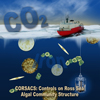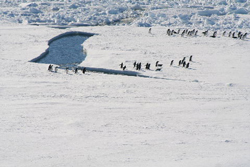

Penguins
popping out of the water onto the ice. (Jack DiTullio)
| CORSACS:
Controls on Ross Sea Algal Community Structure
2005: A Research Cruise to the
Ross Sea to Study What Controls the Phytoplankton DynamicsQuestions
from JCC Heights Preschool, Cleveland Heights January 13, 2006Senna:
Why don’t penguins fly? What is the biggest a penguin can get? Dear
Senna, Penguins have adapted to use their wings as flippers for swimming
rather than for flying. They are excellent swimmers, and they spend most of their
lives at sea or on the ice.The penguins we’ve seen, and have been sending
pictures of, are Adelie penguins. They’re 1.5 to 2 feet tall and weigh about
8-10lbs. There are also Emperor penguins in Antarctica that are much bigger, about
4 feet tall. Thanks for the question,
Mak Philip: Are
there any polar bears there, and if there are, why don’t they get cold? It
looked like people had to wear special suits almost like astronauts, so how do
bears manage? Dear Philip, There are no polar bears down here
in Antarctica. The polar bears never made it down this far south. Looking at a
map you will see that Antarctica is very far away from any other land mass so
it would be a large distance for the bears to travel. It gets very cold down here
and yesterday while we were sampling the seawater froze in our sampling lines.
Therefore we do have to wear special suits to keep us very warm and cozy while
outside. It is a lot of fun to be outside with these suits on as you stay warm
and dry. Polar bears also have special ways to keep warm. They have two different
types of fur. The fur close to their skin is called a downy fur and it acts like
the comforter on your bed which keeps you warm at night. They also have an outer
layer of fur which is coarse and hollow and keeps the downy fur dry and protects
them from the strong winds. When the bear come out of the water after swimming
the downy fur close to their body is dry and it is only the coarse hair which
is wet so they are warm all the time. These bears are also very large and have
a lot of body fat which helps them to stay warm. I hope you are having fun,
Maeve
Emet: If polar bears eat penguins, is this why they live apart? Why
don’t the penguins go even further away to be safe? Dear Emet, As
Maeve wrote, there aren’t polar bears here so the penguins don’t have
to worry about them. The penguins’ main predators here are leopard seals
instead. The penguins here seem remarkably curious, and they come right up to
us sometimes. We’ve seen hundreds of Adelie penguins so far. It is estimated
that there are about 2.5 million breeding pairs in Antarctica, so I think they’re
doing a good job of staying away from the seals. Thanks for the question,
Mak
Phoebe: Can penguins jump up? Dear Phoebe, They can
jump out of the water onto the ice, but this is more from swimming fast out of
the water than jumping. We have seen the Adelie penguins jump between ice floes,
but its not nearly as graceful as when they spring out of the water. I’ve
attached a picture of them jumping out of the water. Thanks for the question,
Mak
Rachel: If penguins can slide on their stomachs, can they roll over
on their backs and slide, too? Dear Rachel, We watched a lot of
the Adelie penguins sliding across the ice on their bellies, using both their
flippers and feet to push themselves along. They wouldn’t be able to push
themselves along if they were on their backs I think. Happy new year,
Mak
Gabriel: Can jellyfish live where you are or is the water too cold?
Are there any sharks there? Dear Gabriel- Thanks for your question
- it's a good one! There are lots of jellyfish here in the ocean surrounding Antarctica.
They don't seem to mind the cold water and there is lots of food for them to eat.
I've seen some really big jellyfish here - up to 3 feet across! These big jellyfish
mostly eat small fish that they catch with their tentacles. In fact, most
kinds of organisms that you find in coastal oceans around the world are also found
here. There are birds and seals, and fish, clams, snails, sea anemones, and algae.
But the species are different. The animals and plants here have to cope with very
cold water, sometimes below freezing even. They also live in a place with giant
blocks of floating ice that bang around and hit each other during storms. You
can imagine that the jellyfish don't like this - they probably go down in the
deeper water during storms. Well, thanks again for your question!
Rob
We all wondered what it is like to live on a ship? Do you have
a kitchen to make food and a bed like we have? How many people can live there
with you? Living on a ship is like sharing a big house with many other
people, some you knew before you got there and some you just met. On our ship,
there are 35 scientists, 10 people to help with our scientific equipment, and
about 15 people on the ship's crew that keep the ship running smoothly. We have
two wonderful cooks who cook meals for us in a big kitchen onboard, called the
galley. We all eat together at big tables, a little like the lunchroom you might
have at school. It's nice to have people cook for us since we are so busy doing
our science work, but some of us really miss cooking in our own kitchens when
we are on the ship. We all have beds for sleeping, in rooms we share with one
or three other people. Everybody has a bunkbed, and all the rooms have a bathroom
attached. Even though we are working very hard, we still need to make time to
relax. For that, there is a room with a television and lots of movies, where people
can go to sit and talk, play card games, or watch movies. When it isn’t too
cold outside, many of us also like to go out on deck and look at the beautiful
scenery, watch for whales and penguins, and get fresh air to relax. There is also
a gym onboard, which is very nice since it is hard to get exercise on the ship.
Many of us use the gym regularly, though it is hard to run on a treadmill sometimes
when the ship is moving a lot! All in all, it is fun living on this ship, though
most of us will be ready to go home and be on land again by the end of our journey. Take
care,
Erin
BACK |

